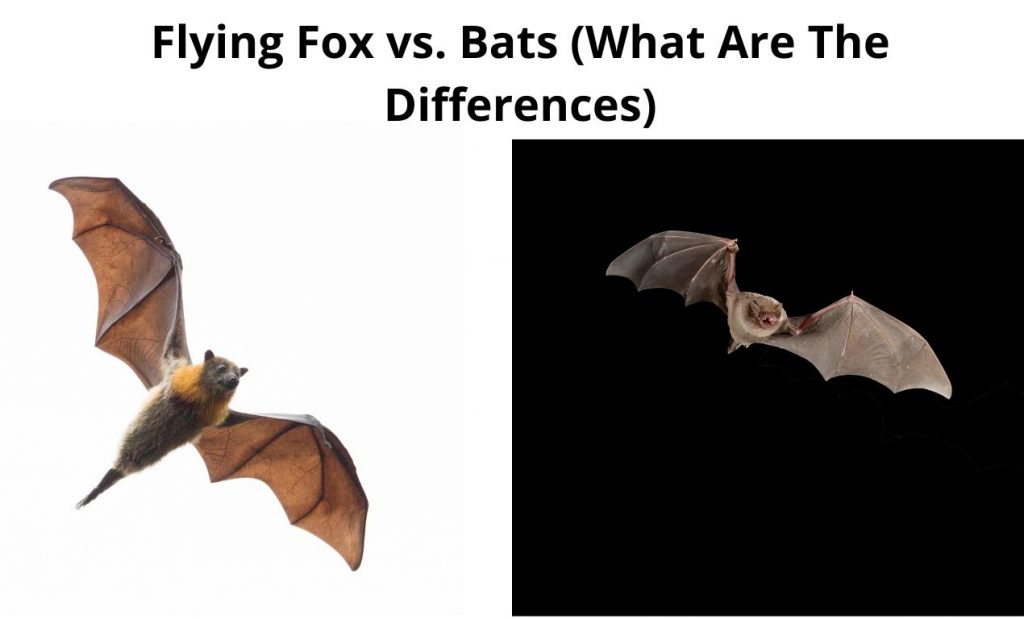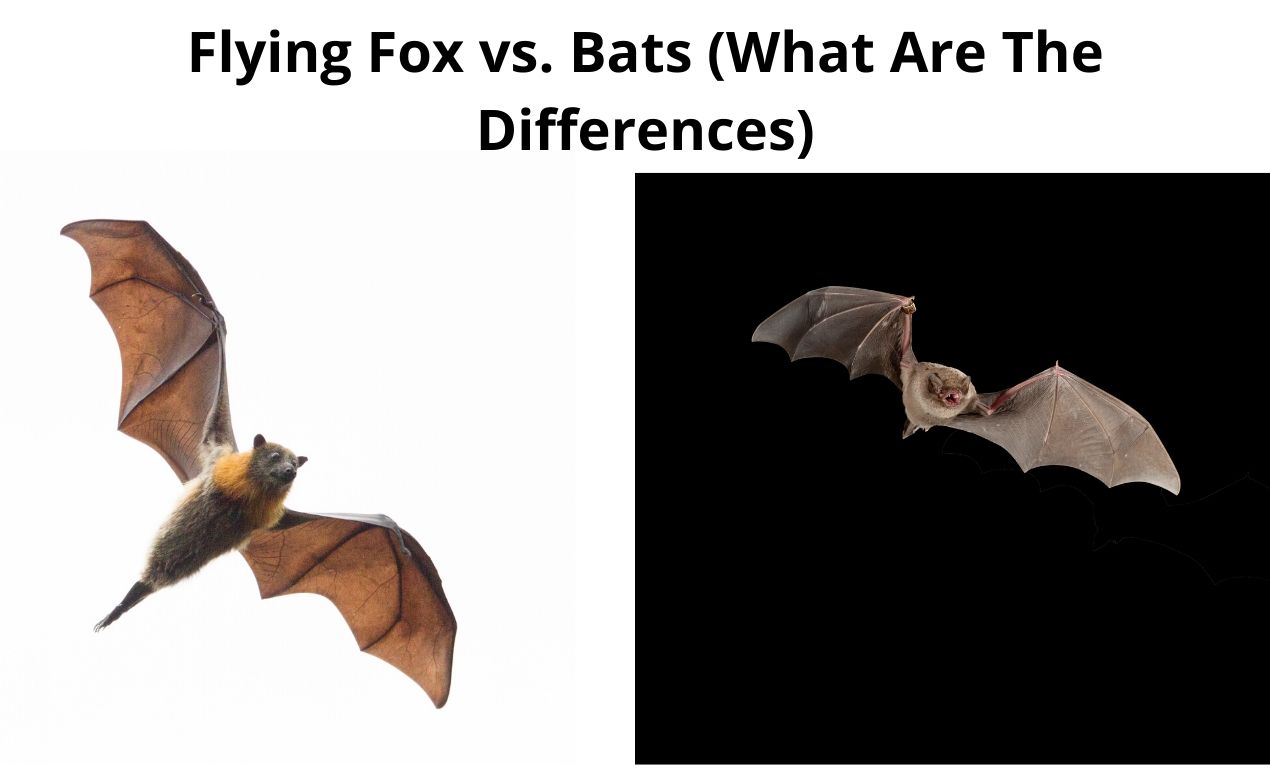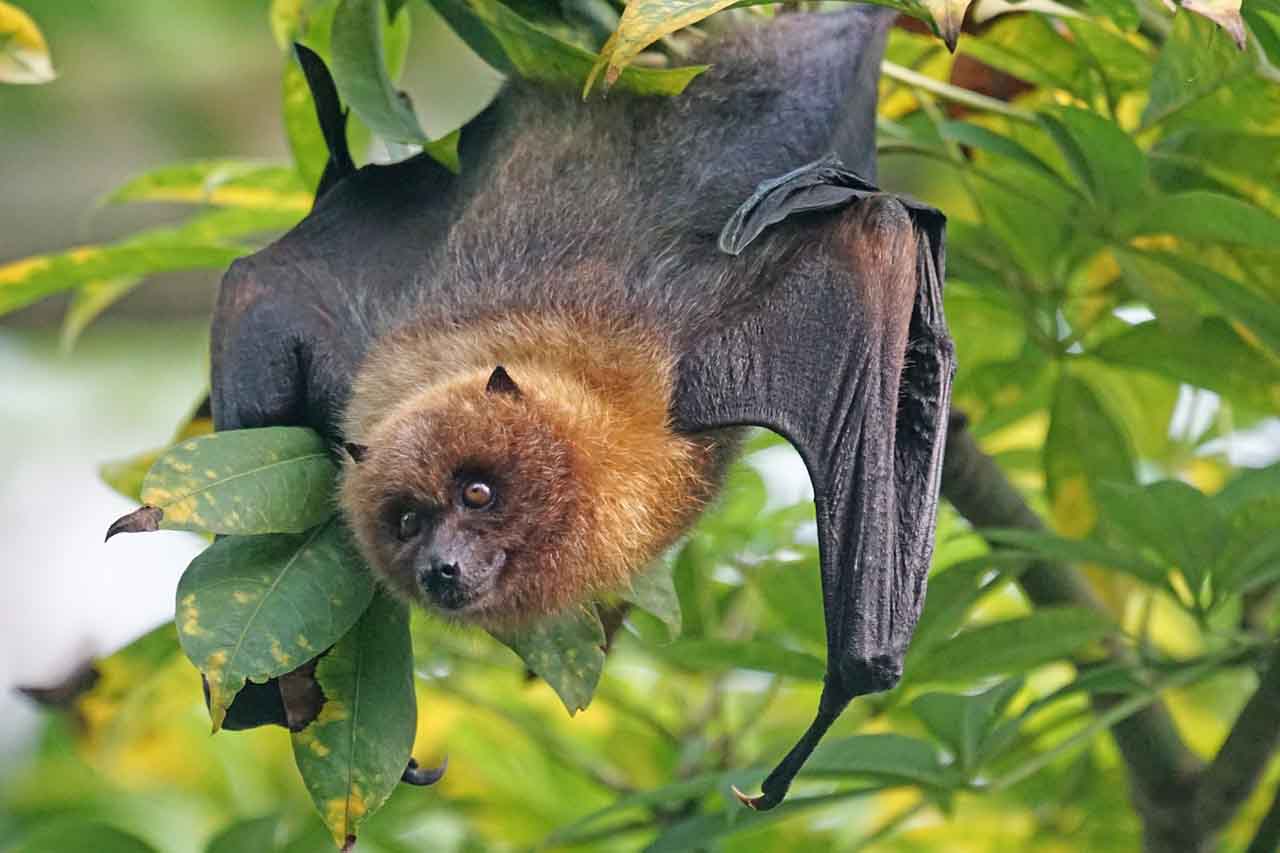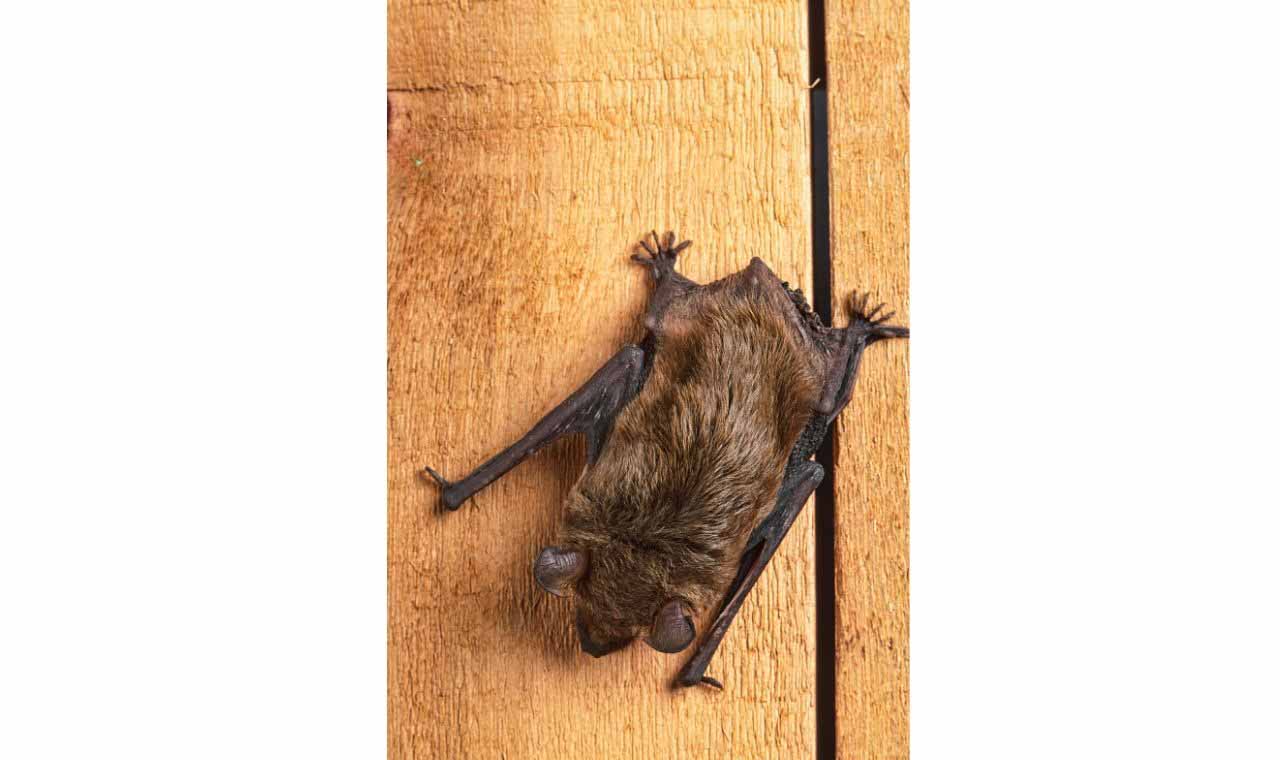
 Flying fox and bats are both mammals and of the order Chiroptera. But they have very distinct features which separates them in unique ways.
Flying fox and bats are both mammals and of the order Chiroptera. But they have very distinct features which separates them in unique ways.
So, flying fox vs. bats what are the differences? Flying fox are largest bats in the world. They like to eat fruits. They are also known as fruit bats on the other hand other bats are much smaller in size and they mainly eat insects and small animals. There are also vampire bats that feed on animal blood but they are much smaller in size.
Flying Fox
Pteropus is a genus of megabats and is the largest in the world. There are around sixty species and are commonly known as flying fox or fruit bats. They eat fruits and other plant supplements, though some also eat insects. Most of them are nocturnal. They have very keen eyesight, with which they navigate excellently at night. They have an excellent sense of smell so that they can locate their food source.
Flying bats are useful to humans and the ecology since they help in pollinating plants and dispersing seeds. However, since they get blamed for destroying crops, they get hunted and killed. Since the females give birth to only one offspring each year, they are slowly becoming extinct. They cannot echolocate.
They are a source of disease to humans thro’ two well-known viruses – the Nipah virus and Hendra Virus. They also spread rabies thro’ Australian bat lyssavirus. These virus has caused death in the past. Flying fox gets featured in mythology, traditional art, folklore, and weaponry. Their fur and teeth got used as currency in the past, while some tribes still use their teeth as a bartering tool.
Bats
Bats comprise 20% of mammal species worldwide and are the most significant order after rodents. They have around 1,200 species. The above megabats or flying foxes are part of this extended family. You also have the microbats. Now, the classification of bats is as follows: Yinpterochiropetra and Yangochiropetra.
Megabats and few microbats are part of Yinpterochiropetra. The rest of the tribe of bats is Yangochiropetra. Along with eating fruits and nuts, bats feed on insects and in some rare varieties of animals and birds. Vampire bats are known the world over, to feed on blood. Microbats are also known as small bats, insectivorous bats, or echolocating bats.
Bats are generally known to be dark and evil, attracting witchcraft, vampires, blood, and death. Their dung gets the stamp of super fertilizer in certain regions. Their sheer numbers attract tourists at their abodes across the world.
Let’s now look at both these mammals under various heads and check out their similarities and otherwise.
Flying Foxes
 Body: Flying fox weigh between 120g to 1.6kg. The wingspan of larger species is widest among all species. Their pelage is dense with thick fur, shiny and long. They don’t have tails. Their head resembles that of a fox, with small pointed ears and large eyes. Males are usually larger than females, who have one set of mammae in their chests. These bats have sharp and curved claws.
Body: Flying fox weigh between 120g to 1.6kg. The wingspan of larger species is widest among all species. Their pelage is dense with thick fur, shiny and long. They don’t have tails. Their head resembles that of a fox, with small pointed ears and large eyes. Males are usually larger than females, who have one set of mammae in their chests. These bats have sharp and curved claws.
Skull and dental formation: Their skull consists of 24 bones, and the adult flying fox has a total of 34 teeth. Their snout consists of 7 bones; the cranium has 16 and the mandible. Like all mammals, the three middle ear ossicles, which transmits sound to the brain. Their dental structure is made up of canines, incisors, premolars, and molars.
Intelligence: These megabats have large brains, similar to domestic dogs. They can identify the places they visit and have long term storage. There is ongoing research concerning some activities they could be trained to accomplish.
Internal System
Flying fox has a large heart, which beats at 100 to 400 beats per minute. They have a simple digestive system, which processes the food in twelve minutes flat!
Senses
Smell: Their sense of smell gets enhanced due to their large olfactory bulbs. They rely to a large extent, on their sense of smell to locate their home, food source, and also their mate. Males have a habit of covering themselves with their urine.
Sight: Flying fox relies on its vision to hunt for food since they lack echolocate capabilities. Their large binocular like eyes are at the front of their heads. They are dichromatic with rods and cones. Since their cones are minimal, they detect blue and green color and can see in low light conditions.
Reproduction And Life-Cycle
Many species of flying foxes are polygynandrous, which means mating with multiple partners. They are known to have an extensive sex life. Though the females are fertile throughout the year, they usually give birth to a pup, only once in a year on an average.
These pups are looked after the mother for about six months, feeding and taking care of them. The general life span among flying fox is between 15 to 28 years, depending upon the species and environment. They reach their sexual maturity in around two years.
Social Life
Most flying foxes are social. They form colonies of individuals with strength between 15,000 to 1 lakh. This depends upon the species of Pteropus. Within this colony, there are various groups co-exist – one male and many female groups; one female and a few male groups, and also male-male groups.
Mating usually takes place during these winter months, and members of these colonies keep constantly changing till summer arrives. During summer, males are on their own, since the females are busy taking care of their pups for the next six months.
Diet And Foraging
Flying foxes primarily feed on flowers, nectar, fruits, nuts, and leaves of trees. Since they feed on all kinds of the plant bearing fruits and nuts, they are considered pests by farmers. Sometimes they feed on small insects like cicadas. What they eat depends on their nutritional needs.
They travel long distances for their food. Sometimes they go out hunting in a group, and there are times, they hunt alone. When they find their food, they hang with their clawed hind feet and use their long-winged forearm claws to grip the food and suck out the extract. The residue skin, seed, and stem of the food are left behind as ejecta pellets.
Ecosystem
The flying fox disperses the ejecta pellets of fruits and nuts after they consume the juice. Incase they have ingested the seeds, these flows out of their gut while flying or moving away from the parent tree. This way, they are known to disperse seeds far away from the orchards.
They are also known to eat pollen of flowers and the nectar. This pollen then stuck to their body, moves to other flowers, thereby germinating them. They are friends of a durian variety of commercial trees. They don’t disturb the flowering and fruit-bearing period and then feed and disburse the ejecta pellets for these trees to multiply.
Captive breeding
Since many species of flying bats are fast dwindling, they are bred in captivity to keep the lineage going. They require ample space to fly around and exercise their muscles.
Human Relationship
Food: They get consumed as bushmeat, which is a delicacy in many regions. This leads to the depletion of this community, which is fast dwindling. Due to the carrier of neurotoxin beta-methylamino-L-alanine (BMAA), which leads to neurodegenerative disease, feeding of bushmeat effects humans. They carry the BMAA virus from the cycad fruits, on which they feed.
Medicine: Flying fox gets killed for preparing a traditional medication to treat a fever with shivering, rheumatism, asthma, and chest pain.
Spread of diseases: They are carriers of various viruses, which affects humans. Rabies gets caused by lyssaviruses. Nipah and Hendra viruses cause sickness among us, which can be fatal if not diagnosed early.
Pests: They classify as pests among farmers and people living in their vicinity. Orchards sometimes get destroyed, especially mangoes, guavas, litchis, and these mammals get blamed. Their strong body odor and being very noisy does not go well human dwellings in the neighborhood.
Culture: Over the years, flying foxes features in folklore, art, and craft. Their teeth and fur get used in fashion and also as currency among certain tribes.
Mummies: A vast number of flying foxes are culled to create these stuffed mummies, which get sold in antique and gift shops across the world.
Bats Or Microbats
 Characteristics: Microbats are 4 to 16cm long on an average. They usually feed on insects. Larger species hunts birds, frogs, lizards, smaller bats, and even fish. Only three species of microbats feed on the blood of mammals or birds. These bats use echolocation to spot their prey.
Characteristics: Microbats are 4 to 16cm long on an average. They usually feed on insects. Larger species hunts birds, frogs, lizards, smaller bats, and even fish. Only three species of microbats feed on the blood of mammals or birds. These bats use echolocation to spot their prey.
Body and dentition: They don’t have the claw in their foreleg. The ears of microbats have a tragus, which helps them with echolocation. Microbats have comparatively smaller eyes. Since these bats eat all kinds of insects, birds, animals and also suck blood, each species have a different dental structure. They have smaller heads, and the jaw structure varies as per their feeding requirement.
Wings: Bats’ wings are much stronger compared to birds since they travel extensively. They have more bones in their arms, and the thin membrane gets tightly stretched on the bony frame. The muscles on their body, where the wings get attached, are very powerful.
Roosting: When they don’t fly, they hang by their feet from their perch. This is called roosting
Internal System
They have a robust respiratory and circulatory system. The digestive system differs as per the food habits of that species. The kidney function and the uterine system vary between bats.
Senses
Echolocation: This is a distinct way; microbats can create a mental image of the location of their prey and also their terrain of flight. Bats generate ultrasound through their larynx, which gets emitted from their mouth or nose. They listen to the echo of this sound, based on which they form images of their surroundings.
Vision: They have small eyes and poor vision. They can detect poor light and only for a short distance since they have a mesopic vision.
Magnetoreception: Bats are sensitive to the earth’s magnetic field and can orient themselves concerning the direction of their flight.
Thermoregulation: Most bats are homeothermic, which is having a stable temperature. Since their dark wings absorb the sun’s radiation, they avoid flying out during the day.
Torpor: This is the relaxing activity of bats during the day. This is very useful for microbats, who are super active at night. They get into hibernation mode during winter, too, with minimum activities.
Food
Most of them, around 70%, feed on all kinds of insects. Some bats prey on other vertebrates, like lizards, frogs, fish, and mammals. A few species, white-winged and hairy-legged vampire bats feed on blood only.
Infection
A large number of microbats fall prey to white-nose syndrome, which is a type of fatal fungal infection.
Breeding
Microbats prefer cave walls to build their colonies in thousands. Females create their nursing colonies where the pup is taken care of by them for six to eight weeks.
Threats
Most of the tree-dwelling bats are in danger due to the mindless chopping of wood. Conservationists are working with government agencies, for the well-being of microbats, worldwide.
Humans
Disease: They carry disease-causing viruses, which is dangerous to humans. If you handle bats, ensure you have protective clothing on. Some recent outbreak of diseases like SARS gets attributed to a species of bats.
Ecosystem: Microbats are useful in keeping crop-eating pests in check. Their droppings are rich fertilizer for crop growing soil.
Smell: Their body odor, urine, and poop are not desirable to humans. Thus, they keep bats at bay.
Conclusion
Bats belong to Chiroptera order, which gets divided into mega and microbats. Megabats or flying foxes are generally herbivores and have a strong sense of smell and sight. While microbats are carnivores, and they rely more on their excellent echolocation capabilities. Though some traits are similar among them like carrying disease-causing viruses, nocturnal mammal, social features, the rest of their characteristics are very different.
Welcome to my blog. I have been doing pest control for years since my house, garden and pets were always attacked by various kinds of pests and as a result I had to know proper pest control techniques that works. In this blog I share all the tips and tricks that I know and I hope you’ll find it helpful.
